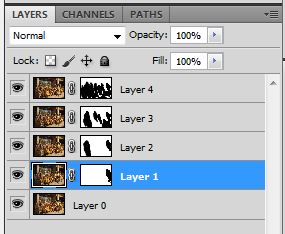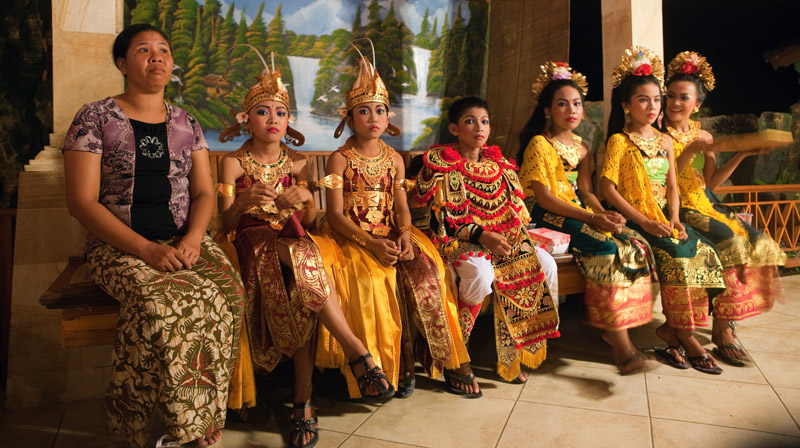I’m really happy with this photo of six young Balinese dancers waiting backstage before their Baris and Legong dance performances, with their teacher/chaperone beside them. I think what I like is the combination of the warm light and colours, the serious composed faces of the dancers, and the way the middle four look at you straight down the lens.
It wasn’t a great situation for photography, with dim low-wattage incandescent lighting. I went up to 1600 ISO on my 5D Mk11, shooting RAW (of course!) and opened up to f/3.5, and even then I needed a 0.4 second exposure to get enough light to the camera sensor! The camera lay beside me balanced on a table as I had no tripod with me at the time. All of this explains the overall softness and the motion blur of the girl on the right hand side.
But this photo is not actually one photo, but a composite of five separate images put together in Photoshop. In reality, at no time was more than one of the dancers looking towards the camera. I chose the best image of each of the subjects, put them into individual layers one Photoshop image (658MB!), and selectively removed parts of each image with layer masks until just the bits I wanted showed through. You can see this in this screenshot from the Photoshop layers pane.
 So, I do like the image – but for me it’s raised a couple of dilemmas about ‘photographic ethics’.
So, I do like the image – but for me it’s raised a couple of dilemmas about ‘photographic ethics’.
Dilemma #1 – Five decisive moments in a single image?
The photo looks like it has simply captured a single moment in time – but in fact it’s an amalgam of five distinct moments, presented as if it was one. So it’s a record of an instant in time that never actually occurred, presented on my web site as if it depicts reality, without any disclosure or explanation.
In this case I don’t suggest it’s a significant manipulation of reality, or a serious deceit. No-ones’s going to be tricked in any serious way – but in a small way the viewer is nonetheless deceived. As the software tools for digital manipulation improve, it’s becoming easy to do this kind of thing without anyone knowing. Should ‘The Ethical Photographer’ always disclose when this kind of manipulation is done?
Dilemma #2 – Candid camera
The second (and perhaps more serious) ethical issue is that this photo (or more correctly, this series of photos) was taken without asking permission first, and without the knowledge of the subjects that their pictures were being taken. The camera lay beside me on the table, facing backwards towards the young dancers sitting on the bench. I was facing in the opposite direction, shooting blind as it were, pressing the shutter button without looking through the viewfinder to frame the shots. They would have had no idea of what I was doing – and, at the time I wasn’t entirely sure either!.
Normally, whether at home in Australia or travelling elsewhere, I make it a rule to ask permission before taking someone’s portrait – unless they are in a public situation, part of a crowd or performing in some way. In Indonesia, one of the first expressions I learnt in Bahasa was: “Boleh saya memfoto Anda?” On this occasion, they were performers – but they weren’t engaged in performance at the time I took the photos. Does that make it unethical? Does the fact that I took the photos covertly make it wrong? What about the fact that they were children?
I haven’t lost any sleep over these dilemmas, but I think it is worth considering what ‘The Ethical Photographer’ would have done in the situation. What do you think? Post a comment below and let me know, eh?
The full set of photos from this night (and other photos taken in and around Amed in eastern Bali) can be seen on the main Jokar web site in this folder.

